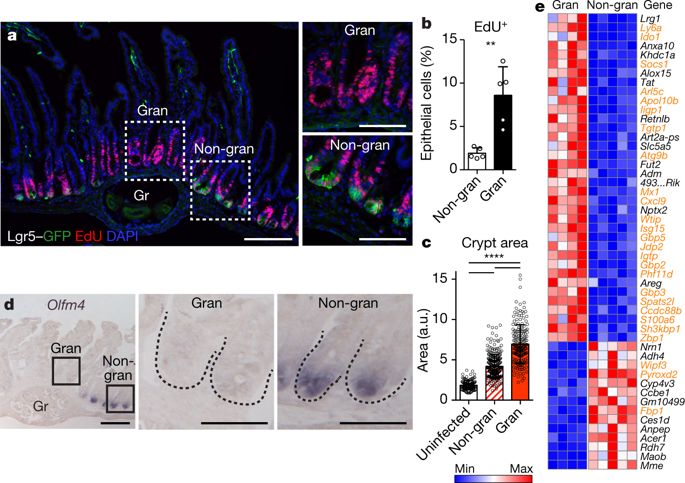Our official English website, www.x-mol.net, welcomes your
feedback! (Note: you will need to create a separate account there.)
Parasitic helminths induce fetal-like reversion in the intestinal stem cell niche
Nature ( IF 50.5 ) Pub Date : 2018-06-27 , DOI: 10.1038/s41586-018-0257-1 Ysbrand M Nusse 1, 2 , Adam K Savage 3 , Pauline Marangoni 2 , Axel K M Rosendahl-Huber 2 , Tyler A Landman 2 , Frederic J de Sauvage 4 , Richard M Locksley 3 , Ophir D Klein 2, 5
Nature ( IF 50.5 ) Pub Date : 2018-06-27 , DOI: 10.1038/s41586-018-0257-1 Ysbrand M Nusse 1, 2 , Adam K Savage 3 , Pauline Marangoni 2 , Axel K M Rosendahl-Huber 2 , Tyler A Landman 2 , Frederic J de Sauvage 4 , Richard M Locksley 3 , Ophir D Klein 2, 5
Affiliation

|
Epithelial surfaces form critical barriers to the outside world and are continuously renewed by adult stem cells1. Whereas dynamics of epithelial stem cells during homeostasis are increasingly well understood, how stem cells are redirected from a tissue-maintenance program to initiate repair after injury remains unclear. Here we examined infection by Heligmosomoides polygyrus, a co-evolved pathosymbiont of mice, to assess the epithelial response to disruption of the mucosal barrier. H. polygyrus disrupts tissue integrity by penetrating the duodenal mucosa, where it develops while surrounded by a multicellular granulomatous infiltrate2. Crypts overlying larvae-associated granulomas did not express intestinal stem cell markers, including Lgr53, in spite of continued epithelial proliferation. Granuloma-associated Lgr5− crypt epithelium activated an interferon-gamma (IFN-γ)-dependent transcriptional program, highlighted by Sca-1 expression, and IFN-γ-producing immune cells were found in granulomas. A similar epithelial response accompanied systemic activation of immune cells, intestinal irradiation, or ablation of Lgr5+ intestinal stem cells. When cultured in vitro, granuloma-associated crypt cells formed spheroids similar to those formed by fetal epithelium, and a sub-population of H. polygyrus-induced cells activated a fetal-like transcriptional program, demonstrating that adult intestinal tissues can repurpose aspects of fetal development. Therefore, re-initiation of the developmental program represents a fundamental mechanism by which the intestinal crypt can remodel itself to sustain function after injury.Larvae of the parasitic helminth Heligmosomoides polygyrus induce granuloma formation and a fetal-like developmental program in granuloma-associated crypts of infected adult mice.
中文翻译:

寄生虫在肠道干细胞生态位中诱导胎儿样逆转
上皮表面形成与外界的重要屏障,并由成体干细胞不断更新 1。尽管上皮干细胞在稳态过程中的动力学越来越被人们所了解,但干细胞如何从组织维护程序中重新定向到损伤后启动修复仍不清楚。在这里,我们检查了 Heligmosomoides polygyrus 的感染,这是一种共同进化的小鼠致病共生体,以评估上皮细胞对粘膜屏障破坏的反应。H. polygyrus 通过穿透十二指肠粘膜破坏组织完整性,十二指肠粘膜在那里发育,同时被多细胞肉芽肿浸润包围。尽管上皮持续增殖,但覆盖在幼虫相关肉芽肿上的隐窝不表达肠干细胞标记物,包括 Lgr53。肉芽肿相关的 Lgr5- 隐窝上皮细胞激活了干扰素-γ (IFN-γ) 依赖性转录程序,以 Sca-1 表达为重点,并且在肉芽肿中发现了产生 IFN-γ 的免疫细胞。类似的上皮反应伴随着免疫细胞的全身激活、肠道照射或 Lgr5+ 肠道干细胞的消融。在体外培养时,肉芽肿相关的隐窝细胞形成类似于胎儿上皮形成的球体,并且 H. polygyrus 诱导细胞的亚群激活了胎儿样转录程序,表明成人肠道组织可以重新利用胎儿的各个方面发展。因此,发育程序的重新启动代表了肠隐窝可以重塑自身以在损伤后维持功能的基本机制。
更新日期:2018-06-27
中文翻译:

寄生虫在肠道干细胞生态位中诱导胎儿样逆转
上皮表面形成与外界的重要屏障,并由成体干细胞不断更新 1。尽管上皮干细胞在稳态过程中的动力学越来越被人们所了解,但干细胞如何从组织维护程序中重新定向到损伤后启动修复仍不清楚。在这里,我们检查了 Heligmosomoides polygyrus 的感染,这是一种共同进化的小鼠致病共生体,以评估上皮细胞对粘膜屏障破坏的反应。H. polygyrus 通过穿透十二指肠粘膜破坏组织完整性,十二指肠粘膜在那里发育,同时被多细胞肉芽肿浸润包围。尽管上皮持续增殖,但覆盖在幼虫相关肉芽肿上的隐窝不表达肠干细胞标记物,包括 Lgr53。肉芽肿相关的 Lgr5- 隐窝上皮细胞激活了干扰素-γ (IFN-γ) 依赖性转录程序,以 Sca-1 表达为重点,并且在肉芽肿中发现了产生 IFN-γ 的免疫细胞。类似的上皮反应伴随着免疫细胞的全身激活、肠道照射或 Lgr5+ 肠道干细胞的消融。在体外培养时,肉芽肿相关的隐窝细胞形成类似于胎儿上皮形成的球体,并且 H. polygyrus 诱导细胞的亚群激活了胎儿样转录程序,表明成人肠道组织可以重新利用胎儿的各个方面发展。因此,发育程序的重新启动代表了肠隐窝可以重塑自身以在损伤后维持功能的基本机制。











































 京公网安备 11010802027423号
京公网安备 11010802027423号